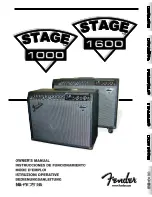
D. B o o s t Le ve l
This allows you to set the level of boost you desire when the boost footswitch is activated.
You have a variable range of 0dB to 9dB of boost available.
E. D. I . O u t p u t
( Tr a n s fo r m e r Co u p l e d )
The D.I. output is a common way to connect directly into the microphone input on a
mixing desk with a standard microphone cable. This output is transformer-coupled for
maximum isolation from noise and ground loop hum. The signal level is set at 0dBu and
will work into a 600-Ohm or higher input impedance, so you will have plenty of signal
strength to send down long cables.
Note: The XLR output is not eff ected by the volume control but is eff ected by all other
controls.
F. G r o u n d L i f t & Tra n s fo r m e r - Co u p l i n g
The transformer-coupled D.I provides full isolation through the D.I. output when the
switch is in the “lift” position to help defeat ground loops that can occur when more
than one connection is made to the D.I.
G . 1 / 4 ” O u t p u t
The 1/4” output, located on the upper left side of the unit, is an unbalanced line level
output. You can plug into any amp or device that has a 1/4” input. This output level is
set by the volume control.
H . D. C . I n p u t
The D.C. power input is designed for a standard 2mm plug commonly used with eff ects
pedals and “fl oor-box” products. Most “wall-wart” or multi-power devices designed for
musical products may be used. The voltage must be greater than 7.5VDC and less than
14VDC. However, you can use any amperage that is 100mA or greater.
IMPORTANT: Polarity of power supply must match polarity marked on back of Venue: Tip (-),
Ring (+).





























